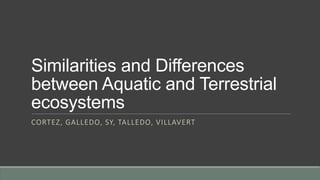
Similarities and Differences between Aquatic and Terrestrial ecosystems
- 1. Similarities and Differences between Aquatic and Terrestrial ecosystems CORTEZ, GALLEDO, SY, TALLEDO, VILLAVERT
- 2. ECOSYSTEM The self-sustaining structural and functional interaction between living and non-living components.
- 4. Aquatic Ecosystem A. Freshwater ecosystem Lentic (Stagnant water)- lakes, ponds Lotic (Flowing water)- river, ocean, sea B. Transitional communities Estauries Wet lands- bogs/ fens, swamps, marshes C. Marine Ecosystem Shorelines Barrier islands Coral Reefs Open Sea
- 5. BOTH ECOSYSTEMS INCLUDE: communities made up of a variety of species populations at the different trophic levels mutual independence among species state of equilibrium in undisturbed terrestrial and aquatic ecosystems
- 6. ABIOTIC CHARACTERISTICS AQUATIC ECOSYSTEMS TERRESTRIAL ECOSYSTEMS LIGHT Increased depth gets lesser amount of light. Available in most terrestrial environments. The amount of light available is important for plant growth. WATER Water is readily available, but access to this water sometimes depends on osmotic factors. Availability varies depending on rainfall or groundwater. IONS Saltwater environments contain dissolved ions such as sodium and chloride. Present in soil GASES Dissolved oxygen increases with decreasing temperature and decreases with depth. Are readily available in the air. Air contains about 20% oxygen and 0.03% carbon dioxide. BUOYANCY VISCOSITY Low viscosity, but is more viscous than air Very low viscosity TEMPERATURE Less variation Temperature experiences daily and seasonal variations. PRESSURE Increases as depth increases. Decreases as altitude increases.
- 7. SIMILARITIES In both terrestrial and aquatic environments the ecosystems include communities made up of a variety of species within both terrestrial and aquatic communities there are populations at the different trophic (nutrient) levels a great deal of mutual interdependence exists between species in both terrestrial and aquatic environments in undisturbed terrestrial and aquatic ecosystems equilibrium is reached i.e. very few major changes are observed over a period of time,
- 8. DIFFERENCES because aquatic environments are so rich in nutrients they support more live than equivalent terrestrial ecosystems. The small drifting photosynthetic organisms of the oceans, referred to collectively as phytoplankton are regarded as the major photosynthesizers, or primary producers of the earth. aquatic environments are much more stable than terrestrial environments, with smaller fluctuations in temperature and other variables. Oxygen (because there is very much less present) is sometimes a limiting factor **an aquatic habitats but this is seldom the case in terrestrial habitats.
- 9. Light can be a limiting factor in some aquatic habitats, but in most terrestrial environments there is hardly ever a shortage of light. terrestrial animals are influenced far more by gravity while water supports aquatic organisms
Notes de l'éditeur
- Natural 1.Terrestrial ecosystems (grasslands, forests, desert ecosystems) 2.Aquatic ecosystem a.Lentic (Stagnant water) like lake, ponds etc. b.Lotic (Flowing water) like river, ocean, sea, etc. Artificial 1.A crop land, garden, aquarium, park, kitchen garden.
